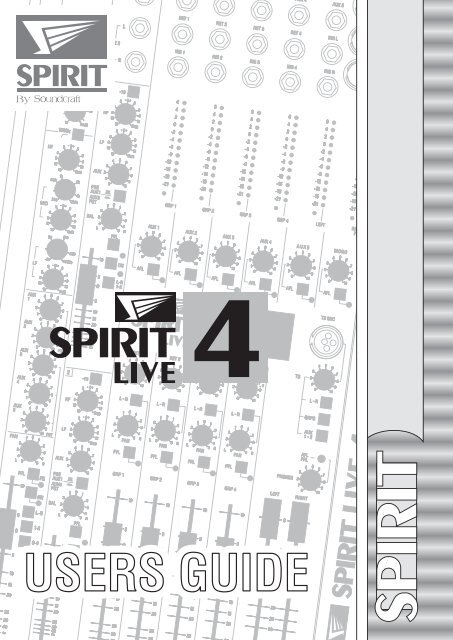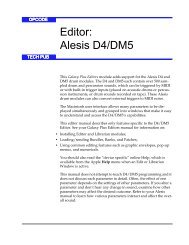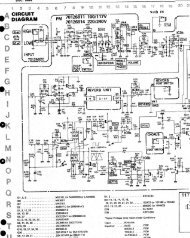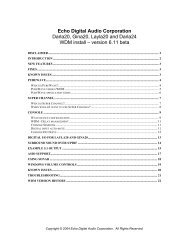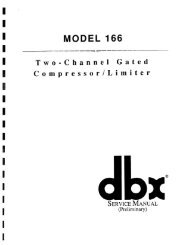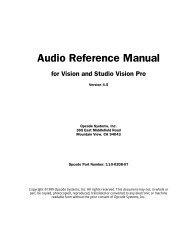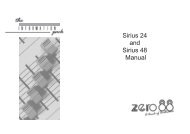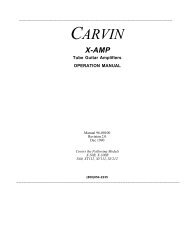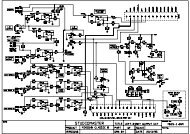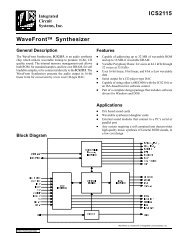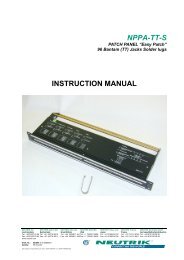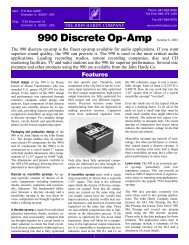soundcraft spirit live 4.pdf - Free Pro Audio Schematics
soundcraft spirit live 4.pdf - Free Pro Audio Schematics
soundcraft spirit live 4.pdf - Free Pro Audio Schematics
- No tags were found...
You also want an ePaper? Increase the reach of your titles
YUMPU automatically turns print PDFs into web optimized ePapers that Google loves.
Use r GuideContentsIntroduction . . . . . . . . . . . . . . . . . . . . . . . . . . . 2Basic Principles of PA Mixing . . . . . . . . . . . . . . . . . 3Getting Started . . . . . . . . . . . . . . . . . . . . . . . . . 6Connections and Connectors . . . . . . . . . . . . . . . 6Fault Finding Guide . . . . . . . . . . . . . . . . . . . . 9Getting to know your console . . . . . . . . . . . . . . . . 10Facilities . . . . . . . . . . . . . . . . . . . . . . . . . 10Input Channel . . . . . . . . . . . . . . . . . . . . . . 10Stereo Sections . . . . . . . . . . . . . . . . . . . . . . 15Group Sections . . . . . . . . . . . . . . . . . . . . . . 17Master Section . . . . . . . . . . . . . . . . . . . . . . 18Using your SPIRIT LIVE 4 Console . . . . . . . . . . . . . 20Initial Set Up . . . . . . . . . . . . . . . . . . . . . . . 20Applications . . . . . . . . . . . . . . . . . . . . . . . . . . 22Public Address . . . . . . . . . . . . . . . . . . . . . . 22Recording . . . . . . . . . . . . . . . . . . . . . . . . . 24Care of your mixer . . . . . . . . . . . . . . . . . . . . . . 25Glossary . . . . . . . . . . . . . . . . . . . . . . . . . . . . 25Selectable Options . . . . . . . . . . . . . . . . . . . . . . 27Specifications . . . . . . . . . . . . . . . . . . . . . . . . . 29Front Panel Layout . . . . . . . . . . . . . fold out rear coverBlock Diagram . . . . . . . . . . . . . . . . . inside rear coverPa g e 1
INTRO DUC TIO NCongratulations on your purchase of a SPIRIT LIVE 4 mixer.Owning a Soundcraft console brings you the expertise andsupport of one of the industry’s leading manufacturers andthe results of over 20 years experience supporting some of thebiggest names in the business.Designed by engineers who understand the individual needsof musicians, SPIRIT LIVE 4 has been built to the higheststandards using quality Japanese components and employingautomated assembly techniques beyond the reach of mostmanufacturers of compact mixers.A rugged steel chassis is combined with moulded side trimsto give protection and distinctive appearance. Custommoulded controls, designed for the best ‘feel’ and visualclarity complement the styling, resulting in a trulyprofessional product which is ideal for both touring and fixedPA installations.SPIRIT LIVE 4 is available in 12, 16, 24 and 32 channel framesizes, and the 12 and 16 channel sizes may be extended byadding an 8 channel Expander. The Expander can be attachedquickly and securely to the console, requiring only ascrewdriver to complete the installation.SPIRIT LIVE 4 incorporates circuit technology identical tothat used on some of the most sophisticated Soundcraftconsoles. The input channels are able to accept a wide rangeof Microphone and Line level signals from separate inputsockets. Every channel features wide range gain control andLine input pad, 3-band Equalisation with swept Mid and LFrange, plus a Hi-Pass Filter, 5 Auxiliary Sends, PFL(Pre FadeListen), Peak LED, Panning to a Stereo Bus and routing inpairs to four Output Groups. Each channel has a separateDirect Output and is controlled by a high-quality long throwfader.All frame sizes are provided as standard with dedicatedstereo inputs, arranged in pairs. One pair is included on the12 channel frame and two pairs on all other frame sizes. Eachstereo input includes a 2-band EQ and a single auxiliary sendcontrol with switching which allows prefade or postfadesourcing with access to three of the five Auxiliary busses. Thestereo channel signal may be routed to either the Mix outputor to Groups 1 & 2 (upper) or Groups 3 & 4 (lower).Pa g e 2
The four Output Groups provide submixing to the Mix L/ Routputs or may feed external equipment directly. Eachincorporates stereo panning and PFL monitoring or bargraphmetering and includes an external Return input for effects orsubmixing from external sources.The Master section provides master level control for the Left,Right, Mono and Auxiliary Send busses, with separate AFLmonitoring on each Auxiliary Send and the Mono output.The Mix L/ R and Group outputs all have insert points for theconnection of external signal processing.Comprehensive Talkback facilities are provided, which allowan external talkback microphone to be routed to Mix L/ R,Groups and Auxes 1 & 2 as required. Six 12-segment, 3-colourpeak reading LED bargraph meters provide clear display ofMix L/ R, Group and PFL signals. Pressing any PFL or AFLswitch puts the selected signal onto both sides of theheadphones output, and the right bargraph meter.SPIRIT Live 4 is designed to be as user-friendly as possible,but a few minutes spent reading through this manual willhelp you become familiar with the product away from thepressure of a <strong>live</strong> session, and allow you to gain full benefitfrom the superb performance offered by your new mixer.Above all, remember that your SPIRIT mixer is designed toextend your creativity. The more you explore the controlsand the effect they have on the sound output, the more youwill appreciate how you can influence and enhance the finalsound.BASIC PRINCIPLES OF PA M IXINGThere was a time when the P.A. system and the operatorexisted only to increase the overall volume of the performers,so that they could be heard in a large room or above highambient noise levels. This just isn’t true any more. The soundsystem and the sound engineer have become an integral partof the performance, and the artists are heavily dependent onthe operator’s skill and the quality of the equipment.The following introduction to the basics of mixing areincluded for the benefit of those users who may not have anysignificant familiarity with sound equipment, and who arebaffled by the endless jargon used by engineers and artistsalike.Pa g e 3
Each input channel and the three main outputs have an Insert‘A’ gauge jack socket, which is a break point in the signalpath. It allows the signal to be taken out of the mixer,through an external piece of equipment and then back into themixer directly after its original exit point. The Insert point isnormally bypassed by the ‘A’ gauge jack socket contacts, andis only brought into operation when a plug is inserted.Typical uses would include Effects <strong>Pro</strong>cessors, Limiters,additional Equalisers or Delay units. In addition, eachchannel has a Direct output which may also be used to feedexternal equipment.The terms PRE and POST are often used in the context ofInserts, Equalisers and Auxiliary Sends, and describe whetherthat facility is placed before (Pre) or after (Post) anotherparticular section. This is explained further in the detaileddescription of facilities.A mixer is often judged, amongst other factors, by the amountof Headroom available. This is a measure of the reserveavailable to cope with sudden peaks in the input signal,without distortion caused by Clipping, when the signalbecomes so high that it would exceed the power supply railvoltages and is as a result limited. This commonly occurswhere gain settings are incorrectly set or where sources areimproperly matched to the mixer input. If the source signal istoo high, clipping and distortion results. If the signal is toolow it becomes masked by the background noise which ispresent to some degree in all mixers. The diagram belowillustrates this point.ClippedSignalNoiseIf the signal level is too high, clipping distortionmay occur.SignalNoiseIf the signal level is too low it may be maskedby the noise.Pa g e 5
GETTING STARTEDCONNECTIONS ANDCONNECTORSAlthough this may seem a simple subject, faulty connectors andcabling are the source of most sound system problems.Correctly-made cables of the proper type, with the rightconnectors for the job will ensure peak performance fromyour system with minimum noise pick-up. The followingsection will help you to connect SPIRIT LIVE 4 correctly.Two different types of audio connectors are used, 3-pin XLRand 1 ⁄4" three pole (‘A’ gauge) jacks. These are used in severalconfigurations as shown in the diagrams below.2. Hot(+ve)3. Cold(-ve)1. Screen2. Hot(+ve)Link 3to 11. ScreenLink 3to 11. Screen2. Hot(+ve)BalancedInputUnbalancedInputUnbalancedOutput3 POLE (stereo) JACK 2 POLE (mono) JACKSendReturnScreenTipRingSleeveHot(+ve)Cold(-ve)ScreenLeft SignalRight SignalGroundSignalGroundTipRingSleeveInsert PointsLine InputAux OutputsFX ReturnsDirect OutputsHeadphonesUnbalancedOutput(see text)Pa g e 6
Ba lanc e d a ndUnba la nce dPola rityAll channel inputs are balanced, i.e. there are separate+ve(hot) and -ve (cold) wires for each signal plus a ground.The design of the differential input amplifiers is such thatinterference picked up on these wires is cancelled out. This isbecause, since both wires are in close proximity, the sameinterference will be picked up on each wire and balancedinput amplifiers will only amplify the difference between+ve(hot) and -ve(cold). Any signal on both hot and cold (i.e.noise) will not be amplified - this is known as common moderejection (CMR). Balanced inputs should always have both+ve and -ve connected or if only an unbalanced source, the-ve pin shorted to ground.Note: many modern audio/ musical instruments haveelectronically balanced outputs which should not beunbalanced by shorting one wire to ground. Always use yourinputs balanced where possible.The Mix L/ R and Mono outputs, Group and Auxiliaryoutputs are ground compensated and provide a very effectiveway of optimising noise immunity, without the cost andcomplexity of balanced outputs. These outputs employground compensation techniques to cancel out the effects ofvariation in ground potential between the mixer and otherequipment which would otherwise show up as hum. If theoutput is driving a device or amplifier that has an unbalancedinput, connect the -ve(cold) signal to the ground at thedestination, not at the output of your SPIRIT LIVE 4 console.You will probably be familiar with the concept of polarity inelectrical signals and this is of particular importance tobalanced audio signals. Just as a balanced signal is highlyeffective at cancelling out unwanted interference, so twomicrophones picking up the same signal can cancel out, orcause serious degradation of the signal if one of the cables hasthe +ve and -ve wires reversed. This phase reversal can be areal problem when microphones are close together and youshould therefore take care always to connect pins correctlywhen wiring audio cables.Grounding a nd Shielding For optimum performance it is vital that all signals arereferenced to a solid, noise-free earthing point and that allsignal cables have their screens connected to ground. Toavoid earth ‘loops’, use balanced connections where possibleand ensure that all cable screens and other signal earths areconnected to ground only at their source and not at both ends.Pa g e 7
+✗UNBALANCED+SourceDevice-Ground loopthrough screenand chassis-MixerSourceDevice+-GND✓BALANCED INPUT+-MixerIf the use of unbalanced connections is unavoidable, you canmimimise noise by following these wiring guidelines:• On INPUTS, unbalance at the source and use a twin,screened cable as though it were balanced. (see below)• On OUTPUTS, connect the signal to the +ve output pin,and the ground of the output device to -ve. If a twinscreened cable is used, connect the screen only at the mixerend. (see below)SourceDevice+GNDINPUT+-MixerMixer+-GNDOUTPUT+GNDOutputDeviceAvoid running audio cables or placing audio equipment,close to thyristor dimmer units or power cables.Noise immunity is improved significantly by the use of lowimpedance sources, such as good quality professionalmicrophones or the outputs from most modern audioequipment. Avoid cheaper high impedance microphones,which may suffer from interference over long cable runs, evenwith well-made cables.Pa g e 8
Fault Finding GuideRepairing a sound mixing console requires specialist skills, butbasic Fault Finding is within the scope of any user if a fewbasic rules are followed.• Get to know the Block Diagram of your console (see insiderear cover)• Get to know what each component in the system issupposed to do.• Learn where to look for common trouble spots.The Block Diagram (see inside rear cover) is a representativesketch of all the components of the console, showing howthey connect together and how the signal flows through thesystem. Once you have become familiar with the variouscomponent blocks you will find the Block Diagram quite easyto follow and you will have gained a valuable understandingof the internal structure of the console.Each Component has a specific function and only by gettingto know what each part is supposed to do will you be able totell if there is a genuine fault! Many ‘faults’ are the result ofincorrect connection or control settings which may have beenoverlooked.Basic Troubleshooting is a process of applying logicalthought to the signal path through the console and trackingdown the problem by elimination.• Swap input connections to check that the source is reallypresent. Check both Mic and Line inputs.• Eliminate sections of the channel by using the insert pointto re-route the signal to other inputs that are known to beworking.• Route channels to different outputs or to auxiliary sends toidentify problems on the Master section.• Compare a suspect channel with an adjacent channelwhich has been set up identically. Use PFL and AFL tomonitor the signal in each section.Pa g e 9
INPUTGETTING TO KNOW YOUR CONSOLERefer to the fold-out front panel diagram which shows thecontrol functions on the SPIRIT LIVE 4. Each facility isdescribed below, and is identified by the reference number.FAC ILITIESINPUT CHANNEL1. MICROPHONE INPUT2. DIRECT OUTPUTThe Microphone input is via a standard female XLR-3connector and is available when the LINE -20dB switch isreleased. It is designed to accept a wide range of balanced orunbalanced low impedance input signals.+48V Phantom Power is available on each input microphonesocket. This is switched on globally from the power supply inthe case of the 12, 16 and 24 channel desks, or from a rockerswitch adjacent to the d.c. power connector at the top right ofthe 32 channel desk. Should you wish to configure inputswithout +48V power, see Selectable Options on Page 27 fordetails of this modification.Transformer-coupled dynamic microphones may be usedwithout causing damage, even when the +48V power isconnected, but care must be taken when using unbalancedsources, because of the voltage present on pins 2 and 3 of theXLR connector. Microphone input level is set by the GAINcontrol(6).NOTE: Phantom powered mics should not be plugged inwith the +48V switched on. Also you should be aware thatsome microphones draw an unusually large current whichmay overload the power supply, resulting in distortion.Consult your microphone supplier for guidance if necessary.A ground compensated DIRECT output is provided, fed fromthe output of the fader buffer, which is therefore unaffectedby the position of the ROUTING switches or PAN control.This provides an ideal source for external processing units,the output of which may be brought back to the consolethrough the STEREO sections or group RETURNS, or todirectly send to the tracks of a tape machine for multitrackrecording. This provides as many Tape Sends as there aremixer channels, without using the group or mix outputs.Pa g e 10
INPUT3. LINE INPUT4. IN SERT5. LIN E SELEC T6. GAIN CONTROLThe LINE Input is a 3-pole 1 ⁄4"‘A’ gauge jack socket, to acceptbalanced or unbalanced line level sources when the LINEswitch(5) is pressed. Unlike the low impedance Microphoneinput, this stage presents a high impedance(>10kΩ) to theinput signal, enabling many types of instruments to beplugged straight in without D.I. boxes or externalpreamplifiers.Line inputs will be found useful as extra Effects Returns,where additional post-effect equalisation is required.The INSERT is a break point in the input channel signal path.It allows the signal to be taken out of the mixer, through anexternal piece of equipment and then back into the mixer tocontinue through to the final output. The Insert is a 3-pole 1 ⁄4"‘A’ gauge Jack Socket, which is normally by-passed. When ajack plug is inserted, the signal path is broken at a point justafter the Hi-Pass Filter, but before the EQ section. The signalfrom the channel appears on the TIP of the plug and isreturned on the RING. The insert point allows limiters,compressors and other signal processing units to be added asrequired to particular input channels and because it is locatedPRE EQ, noise generated by the external equipment may bereduced by a small amount of H.F. cut in the Equaliser.The LINE switch selects Line input when pressed, andMicrophone input when released. When Line is selected theGain range is reduced by 20dB (see 6 below).When the Microphone input is selected this control acts as aSENSITIVITY control covering a 50dB range. Channel signallevel increases as the control is turned clockwise. When theLine input is selected it serves as a GAIN control, with thescaling reduced by -20dB from the printed scale. A nominal0dB input signal will pass through at unity gain, with theknob set at the 20dB position. Some audio equipment,particularly that intended for domestic use, operates at anominal -10dBV level and an increased Gain setting will berequired.Pa g e 11
INPUT7. HI- PA SS FILTERPressing this switch inserts a 12dB per octave 100Hz Hi-PassFilter in the signal path, immediately after the input amplifier.This is particularly useful on <strong>live</strong> vocals, and its use isstrongly recommended, even on male vocals. It can also beused for filtering out low frequency hum.Frequency Response Curves of the Hi-Pass FilterdB HI-Pass Filter4.03.02.01.00.0-1.0-2.0-3.0-4.020 100 1k 10k 20kFrequency/Hz8. EQ UA LISERThe Equaliser(EQ) comprises three sections. The uppercontrol provides H.F.(treble) boost and cut of +/ -15dB. Thelower two pairs of knobs are arranged as a cut/ boost control(lower knob) of +/ - 15dB, and a SWEEP(frequency) controlwhich determines at which frequency the boost/ cut actionwill be centered. The LF sections are essentially Swept LowFrequency controls, covering a range from 40 to 400Hz andproviding much greater flexibility than a conventionalLF(bass) control. The MID section, with a frequency rangefrom 250Hz to 8kHz is particularly versatile for vocals,enabling particular characteristics of the singer to be lifted orsuppressed very precisely.Frequency Response Curves of the EqualiserdB LF Section20.015.010.05.00.0-5.0-10.0-15.0-20.020 1001k 10k 20kFrequency/HzPa g e 12
INPUTFrequency Response Curves of the EqualiserdB MID Section20.015.010.05.00.0-5.0-10.0-15.0-20.020 1001k 10k 20kFrequency/HzdB HF Section20.015.010.05.00.0-5.0-10.0-15.0-20.020 1001k 10k 20kFrequency/Hz9. AUXILIARY SENDSThese controls route the input channel signal to any one ormore Auxiliary busses. These are separate from the mainoutputs and can therefore provide additional outputs forfoldback, echo units or extra loudspeaker ‘fills’.AUX 1 & 2 are derived before the channel fader(PRE FADE),and are therefore unaffected by the fader position. Thismakes them particularly suitable for foldback or monitorfeeds, which need to be controlled separately from the mainP.A. mix.AUX 3, 4 and 5 are derived after the channel fader(POSTFADE), and therefore follow any changes in fader level. Theyare normally used to drive effects processing units which arefed back into the mixer and which must fade out with theinput channel.AUX 2 may be altered internally to be POST FADE. Refer tothe Selectable Options section (Page 28) for a description ofthis modification.All of the Aux Sends are muted when the ON switch(12) isreleased.Pa g e 13
INPUT10. PAN11. PFL/ PEAK LED12. ON SWITCH13. ROUTING SWITCHES13. CHANNEL FADERThe PAN control determines the position of the signal withinthe stereo mix image or may be used to route the channelsignal to particular output GROUPS as selected by theROUTING SWITCHES (13). Rotation fully anticlockwisefeeds the signal solely to the Left mix buss or Groups 1 and 3,while rotation clockwise sweeps the image to the right buss orGroups 2 and 4.When the PFL switch is pressed, the Pre-Fade signal is fed tothe headphones, where it replaces the selected source. ThePFL/AFL LED on the master section illuminates to warn thatthe headphones and the meters are now responding to thePFL/ AFL selection and the PFL LED on the input channellights to identify the active channel. This is a useful way oflistening to any required input signal without interrupting themain mix, for making adjustments or tracing problems.When the PFL switch is released the LED on the channelserves as a PEAK indicator, to warn when an excessively highsignal level is present in the channel. The signal is sampledat two points in the channel, immediately after the inputamplifier (PRE HI-PASS FILTER & PRE INSERT) and POSTEQ. The Peak LED will illuminate approximately 4dB beforeclipping and therefore give warning of a possible overloadeven if the peaks are removed by external equipment pluggedinto the Insert.The ON switch enables all outputs from the channel whenpressed, and the associated LED illuminates to show that thechannel is active.The input channel signal may be routed to the main STEREOMIX (L-R) or pairs of GROUP busses (1-2, 3-4), by pressingthe respective switches. These may be used in conjunctionwith the PAN control (10 above) to route the channel signalproportionately to any of the selected busses.This long-throw fader determines the proportion of thechannel in the mix and provides a clear visual indication ofchannel level. Normal operating position is at the ‘0’ mark,providing 10dB of gain above that point if required.Pa g e 14
STEREOSTEREO SEC TIO NS1. STEREO IN PUTS2. -10 SWITCH3. EQ UA LISA TIO NEach Stereo Input section comprises a pair of similar inputs.The inputs are electronically balanced and separate jacks areprovided for the Left and Right source signals. A mono signalmay be plugged into the upper socket only for each pair to befed equally to left and right busses.The input jacks are normally set to match +4dBu nominalsignal levels. Pressing the -10 switch alters the inputsensitivity to match the -10dBV signals from most Hi-Fisystems or semi-professional tape machines allowing theinputs to be quickly switched to match, for instance, a cassetteplayer for pre-show music.Each Stereo Input is provided with a 2-band shelving EQsection giving ±15dB boost & cut at fixed frequencies of 60Hzand 12kHz.Frequency Response Curves of the EqualiserdB LF Section20.015.010.05.00.0-5.0-10.0-15.0-20.020 1001k 10k 20kFrequency/HzdB HF Section20.015.010.05.00.0-5.0-10.0-15.0-20.020 1001k 10k 20kFrequency/HzPa g e 15
STEREO4. A UX SEN D5. A UX SELEC TIO N6. BALANCE7. PFL8. ON9. ROUTINGA single control feeds a mono sum of the stereo signal to achoice of Aux Send busses (see 5 below).The flexibility of the Aux send control (4) is maximised by achoice of destinations on the two Stereo sections. On theupper section (Stereo 1) this switch routes the Aux Send toeither AUX 1 (Prefade) when released, or AUX 3 (Postfade)when pressed. On the lower section the choice is betweenAUX 1 (Prefade) when released and AUX 4 (Postfade) whenpressed.The BAL control sets the relative level of the Left and Rightsignals. In the centre position its gain is unity. Turning thecontrol fully clockwise increases the Right signal by +4dB,and totally kills the Left signal. Full anticlockwise rotationhas the opposite effect. Balance left biases the signal to theLeft buss and Groups 1 & 3, balance right to the Right bussand Groups 2 & 4.When the PFL switch is pressed the prefade signal is fed tothe Headphones where it replaces the selected source. TheAFL/PFL LED on the Master Section illuminates to warn thatthe headphones and RIGHT/PFL METER are nowresponding to the PFL selection and the PFL LED on theStereo Section lights to identify the active source.Pressing this switch turns ON the feeds to the Aux Sends andoutput busses. The associated LED illuminates to show thatthe section is active.A single Routing Switch per section provides access to MixL-R and Groups 1-2 or 3-4. The upper section routes betweenMix L-R with the switch released, and Groups 1-2 whenpressed. The lower section routes between Mix L-R with theswitch released and Groups 3-4 when pressed. The relativelevels of the left and right signals is controlled by theBALance control (6).Pa g e 16
GROUP10. FADERLinear faders are provided for precise and smooth levelcontrol for each Stereo section.GROUP SECTION1. RETURN2. IN SERT3. RETURN LEV EL4. PAN5. PFL6. GROUP FADERA mono Return is provided to each output Group, which isintended for use as a sub-mix from another desk or as aneffects input. The input is electronically balanced on astandard 1 ⁄4" 3-pole ‘A’ gauge jack.An Insert is provided for each output Group to allow externalprocessing equipment to be ‘inserted’ into the output path.The 1 ⁄4" 3-pole ‘A’ gauge jacks are bypassed except when aplug is inserted.The level of the signal at the RETURN input (1, above) is setby a rotary control. A panel marking indicates the nominalunity gain position.The Group PAN control determines the position of the signalwithin the stereo image which is routed to the mix L/ R busseswhen L-R is pressed. Rotation fully anticlockwise feeds thesignal solely to the Left mix buss, while rotation clockwisesweeps the image to the right.When the PFL switch is pressed, the pre-fade Group signal isfed to the headphones and RIGHT/PFL METER where itreplaces the mix signal. The AFL/PFL LED on the mastersection illuminates to warn that the headphones and meterare now responding to the AFL/ PFL selection and the PFLLED on the Group lights to identify the active Group.Long throw faders are provided for each Group with unitygain at the top of their travel.Pa g e 17
M A STER7. GROUP OUTPUTThe Group outputs are driven by ground compensatedamplifiers to a standard 1 ⁄4" 3 pole ‘A’ gauge jack socket.M ASTER SEC TIO N8. D.C. POWER SOCKET9. MONO OUTPUT10. MIX L & R OUTPUTS11. INSERTS12. BA RG RAPH M ETERSThe cable from the power supply connects to the console viathis 5-pin socket.Ensure that you always use the correct power supply for yourconsole. The 12, 16 and 24 channel frame sizes require theDCP100 power supply and the 32 channel frame uses theCPS150 power supply.The ground compensated MONO output is a sum of thepostfade Mix Left and Right outputs, providing a separatelycontrolled feed which may for instance be used to drive acentre loudspeaker cluster via a suitable power amplifier.The MIX L & R outputs are standard male XLR-3 connectors,driven by ground compensated amplifiers.These are similar to the Input Channel Inserts and allowexternal processing equipment to be ‘inserted’ into the outputsignal path. The 1 ⁄4" 3 pole ‘A’ gauge jack sockets areby-passed except when a plug is inserted.Six 12-segment, three colour bargraph meters provide visualmonitoring of the levels of the Mix Left and Right, and Groupoutputs. All the meters are peak reading.Normally the Left and Right meters show the level of the MixLeft and Right outputs. If any PFL or AFL switch is activatedthe left meter is turned off and the right meter displays thelevel of the selected PFL or AFL signal.The bargraphs may be calibrated by trimmers accessed viaholes in the panel below each meter. Adjustments may bemade using a small screwdriver, taking care not to damagethe trimmers.Pa g e 18
M A STER13. MONO14. AUXILIARY MASTERS15. AUXILIARY OUTPUTS16. TALKBACK17. HEADPHONE VOLUME18. MIX FADERSThe level of the MONO output (9) is set by a rotary fader.The associated AFL switch with indicating LED monitors thefinal output after the fader.Each of the Auxiliary Send busses is provided with a rotarymaster level control and an AFL switch with indicating LEDwhich monitors the final output after the fader.The Auxiliary Send outputs are driven by groundcompensated amplifiers to a standard 1 ⁄4" 3 pole ‘A’ gaugejack socket.A female XLR-3 connector provides the input for a headphonemounted, gooseneck or floating dynamic microphone forTALKBACK to selected outputs. Level is set by the TBcontrol and three switches route the signal selectively to MixL-R, Groups (GRPS) or AUX 1-2.This control sets the level of the PHONES output at the socketbelow the front armrest. Normally this is fed by the Mix L/ Routput, unless an AFL or PFL switch is pressed, in which casethe Mix signal is replaced by the AFL/ PFL signal and theAFL/PFL LED lights to show that the AFL/ PFL system isactive.Note that due to the way that the ground compensatedoutputs operate, it is possible that a hum might be audibleunder AFL listening, which is in fact cancelled on the actualoutput. This would indicate that there is a ground loop inyour system which you may wish to correct.Master faders for Left and Right mix outputs. Unity gain is atthe top of their travel.Pa g e 19
USING YOUR SPIRIT LIVE 4 CONSOLEThe final sound from your P.A. system can only ever be asgood as the quality of the source signal. Just as you need tobecome familiar with the control functions of your mixer, soyou must recognise the importance of correct choice of inputs,microphone placement and input channel settings. However,no amount of careful setting up can take account of thespontaneity and unpredictability of <strong>live</strong> performance and themixer must be set up to provide ‘spare’ control range tocompensate for changing microphone position and theabsorption effect of a large audience (different acousticcharacteristics from sound check to show).The front panel drawing inside the rear cover showstypical initial control positions which may be found auseful guide to setting up the mixer for the first time.Initial Set UpThe diagram on page 5 demonstrated how the matching ofinput gain to the signal source was crucial to avoid distortionat one extreme and excessive noise at the other. Set upindividual input channel as follows:• Connect the input required (microphone, keyboard etc.)Note: Phantom powered mics should be connected beforethe +48V is switched on.• Set Master faders at 0, input faders at 0, and set poweramplifier levels to about 70%.• <strong>Pro</strong>vide a typical performance level signal and press thePFL button on the particular channel, monitoring the levelon the right-hand meter.• Adjust the input gain until the meter is just reaching theamber section (0dB) at a typical maximum source level.This allows sufficient headroom to accommodate peaksand establishes the maximum level for normal operation(but see note below).• Repeat this procedure on other channels as required. Asmore channels are added to the mix, the meters may moveinto the red section. Adjust the overall level using theMaster Faders if necessary.Pa g e 20
• If you cannot obtain a satisfactory setting, e.g. the gaincontrol is right at the extreme low end of the scale onMicrophone Input, try using the Line Input instead.• Listen carefully for the characteristic sound of ‘feedback’.If you cannot achieve satisfactory input level settingwithout feedback, check microphone and speakerplacement and repeat the exercise.You are now ready to start building the mix and this shouldbe done progressively, listening carefully for each componentin the mix and watching the meters for any hint of overload.If this occurs, back off the appropriate Channel Fader slightlyuntil the level is out of the red segments, or adjust the MasterFader.Note: The level of any source signal in the final output isaffected by many factors, principally the Gain control,Channel Fader and Output Faders. You should try to use onlyas much microphone gain as required to achieve a goodbalance between signals, with the faders set as describedabove. If the input gain is set too high, the channel fader willneed to be pulled down too far in compensation to leaveenough travel for successful mixing and there is a greater riskof feedback because small fader movements will have a verysignificant effect on output level. If the gain is set too low,you will not find enough gain on the faders to bring the signalup to an adequate level.Microphone PlacementCareful microphone placement and the choice of a suitabletype of microphone for the job is one of the essentials ofsuccessful sound reinforcement. The aim should be to placethe microphone as close as physically possible to the source,to cut out unwanted surrounding sounds, allow a lower gainsetting on the mixer and avoid feedback. Also a well-chosenand well-placed microphone should not need any appreciableequalisation.Pa g e 21
APPLICATIONSExample 1 - PublicAddre ss - Stere o OutputSPIRIT LIVE 4 is designed primarily as a soundreinforcement mixer, but may also be used for basicmultitrack recording. The following diagrams show typicalconfigurations which will illustrate how the mixer isconnected to other equipment.In this basic set-up, an assortment of sources are connected tothe input channels, microphone to mic. inputs, and akeyboard and guitar to line inputs. Note that some guitarswould not produce sufficient level for a direct connection, andwould require a D.I. box connected via the microphone input.The mix L/ R outputs are connected to the power amplifierand speakers, and a compressor/ limiter is included in thePa g e 22
output signal path via the Left and Right insert points.Exa m ple 2: Pub licAddre ss - Stere o+ Centre FeedIn this second example the Group 1 Output is used to drive anadditional centre speaker, with individual fader control. Therouting on the input channels allows individual selection tothe Centre output by routing to Group 1.Exa m ple 3: Pub licAddre ss - M ono O utputIn this example the console is used to feed loudspeakers inMono only. The compressor remains in the Left and RightInserts for use on these outputs if required. A feed fromanother mixer is submixed to the desk on Returns 1 & 2. Notethat the Groups may be used for subgrouping channels to theFROMSUBMIXERPa g e 23
final output.Exa m ple 4:Stereo RecordingThe console may also be used for 2-Track or basic multitrackrecording <strong>live</strong> or in the studio. The set up is similar to theprevious examples but with the Mix L/ R Output feeding a2-track Tape Machine. Aux 1 is used to provide artistsfoldback on headphones, and Aux 3 and 4 feed a reverb unit2 TRACK TAPEMACHINEREVERBwhich is returned to the console on RET1 and RET2.Exa m ple 5:Multitra ck RecordingIn this last example the mixer is connected to a multitracktape machines, and the main outputs to a 2-track machine formixdown. Once again a compressor has been included in theinsert points.Feeds to the multitrack are taken from the channel DIRECToutputs. Outputs from tape are fed back to the channel lineinputs and can be mixed down to the stereo mix output asrequired. Aux 3 & 4 feed an effects unit as in the previousEFFECTS PROCESSORPa g e 24
CARE OF YOUR MIXERGeneral PrecautionsAvoid storing or using the mixer in conditions of excessiveheat or cold, or in positions where it is likely to be subject tovibration, dust or moisture.Keep the mixer clean using a soft dry brush, and anoccasional wipe with a damp cloth or ethyl alcohol. Do notuse any other solvents which may cause damage to paint orplastic parts.Avoid placing drinks or smoking materials on or near themixer. Sticky drinks and cigarette ash are frequent causes ofdamage to faders and switches.Regular care and inspection will be rewarded by a long lifeand maximum reliability.G lossa ryauxiliary sendbalanceclippingdB (decibel)DI(direct injection)direct outputequaliseran output from the console comprising a mix of signals fromchannels and groups derived independently of the mainstereo/ group mixes. Typically the feeds to the mix areimplemented on rotary level controls.the relative levels of the left and right channels of astereo signal.the onset of severe distortion in the signal path, usuallycaused by the peak signal voltage being limited by thecircuit’s power supply voltage.a ratio of two voltages or signal levels, expressed by theequation dB=20Log10 (V1/ V2). Adding the suffix ’u’ denotesthe ratio is relative to 0.775V RMS.the practice of connecting an electric musical instrumentdirectly to the input of the mixing console, rather than to anamplifier and loudspeaker which is covered by a microphonefeeding the console.a post fade line level output from the input channel, bypassingthe summing amplifiers, typically for sending to individualtape tracks during recording.a device that allows the boosting or cutting of selectedbands of frequencies in the signal path.Pa g e 25
feedbackfoldbackfrequency response(sub) groupheadroomhighpass filterline level signalsmono outputpan (pot)peakingPFL (pre-fade listen)rolloffshelvingspilltalkbacktransientthe ‘howling’ sound caused by bringing a microphonetoo close to a loudspeaker driven from its amplified signal.a feed sent back to the artistes via loudspeakers orheadphones to enable them to monitor the sounds they areproducing.the variation in gain of a device with frequency.an output into which a group of signals can be mixed.the available signal range above the nominal levelbefore clipping occurs.a filter that rejects low frequencies.at a nominal level of -10 to +6dBu, usually coming from a lowimpedance source.a mono sum of the left/ right mix outputs, providing aseparately controlled line level feed for additionalloudspeakers.abbreviation of ’panorama’: controls levels sent to leftand right outputs.an equaliser response curve affecting only a band offrequencies i.e. based on a bandpass response.a function that allows the operator to monitor the pre-fadesignal in a channel independently of the main mix.a fall in gain at the extremes of the frequency response.an equaliser response affecting all frequencies above orbelow the break frequency i.e. a highpass or lowpass derivedresponse.acoustic interference from other sources.the operator speaking to the artistes or to tape via theauxiliary or group outputs.a momentary rise in the signal level.+48V the phantom power supply, available at the channel micinputs, for condenser microphones and active DI boxes.Pa g e 26
Selectable OptionsRemoval of +48V on Mic InputsTo disable the +48V phantom powering on the microphoneinputs, remove link J3 from Input PCB SC3209. This can bedone without removing the PCB as shown below, by carefullycutting the leads of the link above the PCB at the pointsmarked.To reinstate the +48V, fit a replacement link, Part No. AZ2222,which is available from your dealer.INPUT BOARD SC3209JSKT1JSKT2JSKT3CUTJ3CUTC6D3C26C4IC1L5C22R24R26Edge view of PCBR19R34R25J3Pa g e 27
Reconfiguring Aux 2 as a Post Fade SendAux 2 is configured as a PRE FADE send at the factory, butmay be altered to be POST FADE if required by repositioninga link on the Input PCB SC3209 as shown below.INPUT BOARD SC3209J1J2PREPOSTJ1J2L10C28C27R56R54R52R51R50PREPOSTR48To change AUX 2 to POST FADE, remove the PCB from theconsole and carefully unsolder link J1 using the minimum ofheat to avoid the possibility of tracks lifting on the PCB.Replace the link in position J2.This operation should only be carried out by competenttechnicians who possess the necessary soldering skills.Pa g e 28
SPEC IFIC ATIO NSTypical Figures for a 16 Channel ConsoleNOISEMeasured RMS, 22Hz to 22kHz BandwidthLine inputs selected at unity gain and terminated 150RMIX NOISEInput faders down, channels routed to L-R, Pans central, Masters at maximumMix Left -82dBuMix Right -82dBuAUX NOISEInput faders down, Aux outputs at maximum, Four Stereo sections routed to Aux 1Aux 1-81dBuAux 2-84.5dBuAux 3-84.5dBuAux 4-84.5dBuAux 5-84.5dBuGROUP NOISEInput faders down, channels routed to Groups, Pans central, Group gain at unity.Group 1 -84.5dBuGroup 2 -84.5dBuGroup 3 -84.5dBuGroup 4 -84.5dBuE.I.N.Microphone Input,Maximum Gain, terminated 150RC RO SSTALKChannel ON switch IsolationMax. Channel Fader AttenuationRouting Switch IsolationMax. Master Fader AttenuationMax. Group Fader AttenuationMax. Aux Send AttenuationMax. Stereo Fader AttenuationStereo ON switch IsolationStereo Routing Switch Isolation-127.8dBu> 103dB to Mix L/ R @ 1kHz> 87dB @ 10kHz, > 97dB @ 1kHz> 87dB @ 10kHz, > 105dB @ 1kHz> 100dB wide band> 90dB @ 10kHz, > 100dB @ 1kHz> 85dB @ 10kHz, > 90dB @ 1kHz> 95dB @ 1kHz> 100dB wide band> 90dB @ 1kHzPa g e 29
DISTORTIONTHD measured at +20dBuLine Input to Mix Output< 0.0025% @ 1kHz, < 0.015% @ 10kHzINPUT & O UTPUT IM PEDANC ESMicrophone Input> 2kΩLine Input> 10kΩInsert Sends75ΩInsert Returns10kΩOutputs75ΩINPUT & O UTPUT LEV ELSMic Input Maximum LevelLine Input Maximum LevelMix Out Maximum LevelMono Out Maximum LevelAux Out Maximum LevelMETERING12 Segment LED BargraphAccuracy Relative to 0dB+10dBu+30dBu+21dBu+21dBu+21dBu+/ - 1dBPa g e 30
Unit C6, Hastingwood Trading Estate35, Harbet Road, London, N18 3HUPhone 020 8803 7400 email office@gradav.co.ukFAX 020 8803 5060 Web www.gradav.co.uk


